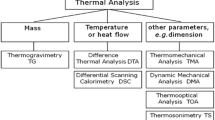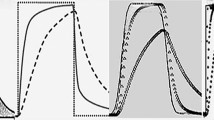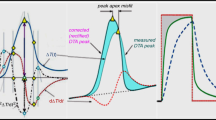Abstract
The experimental conditions influencing thermoanalytical results are summarized and subdivided into three groups: sample properties, experimental parameters, apparative parameters. By means of selected examples, some experimental conditions are discussed, mainly for TG and DTA. Special care is given to particle size, the atmosphere as part of the reacting system and as experimental parameter, the buoyancy problem, dynamic re-impact phenomena of molecules, heat transfer and supercooling problems in melting, and DTA under different isobaric conditions. In quantitative thermal analysis, experimental conditions need careful control. Standard reference materials as well as automatic data collection and processing techniques help in achieving better thermoanalytical results.
Résumé
On passe en revue les conditions d'expériences qui influencent les rés iltats de l'analyse thermique et on les classe en trois groupes: les propriétés de l'échantillon, les paramètres d'expérience et les paramètres propres aux appareils. On discute, à l'aide d'exemples, quelques conditions d'expérience, en considérant surtout la TG et l'ATD. On examine en particulier la grandeur des particules, l'atmosphère en tant que partie du système réagissant et en tant que paramètre d'expérience, le problème de la force ascensionnelle, le phénomène de choc dynamique répété des molécules, le transfert de chaleur et les problèmes de retard à la fusion lors du refroidissement ainsi que l'ATD sous diverses conditions isobares. Lors de l'analyse thermique quantitative, les conditions d'expériences doivent être minutieusement contrôlées. L'emploi de substances étalons de référence ainsi que l'acquisition et le traitement automatiques des données peuvent contribuer à parvenir à de meilleurs résultats.
Zusammenfassung
Die die thermoanalytischen Ergebnisse beeinflussenden Versuchsbedingungen wurden zusammengefaßt und in drei Gruppen unterteilt: Eigenschaften der Probe, Versuchsparameter, Parameter des Geräts. An Hand ausgewählter Beispiele werden einige Versuchsbedingungen, hauptsächlich betreffs TG und DTA, erörtert. Eine besondere Aufmerksamkeit wird der Partikelgröße, der Atmosphäre als Teil des Reaktionssystems und als Versuchsparameter, dem Problem der Auftriebskraft, dem dynamischen Wieder-Einschlagphänomen der Moleküle, der Wärmeübertragung und den Problemen der Unterkühlung beim Schmelzen und der DTA bei verschiedenen isobaren Bedingungen gewidmet. Bei der quantitativen Thermoanalyse benötigen die Versuchsbedingungen ein sorgfältiges Regeln. Standard Referenzsubstanzen sowie Techniken der automatischen Datensammlung und -verarbeitung können zum Erhalten besserer thermoanalytischer Ergebnisse verhelfen.
Резюме
Экспериментальные у словия, затрагивающи е термоаналитические результаты, обобщены и подраздел ены на три группы: свой ства вещества, эксперимен таль-ные и аппаратурные парам етры. На примере выбра нных образцов обсуждены н екоторые экспериментальные р езультаты, главным об разом для ТГ и ДТА. Особое вни мание уделено размеру част иц, атмосфере как част и реакционной системы и как эксперименталь ному параметру, проблеме плавучести, явлению динамическо го соударения молекул, проблемам пе реноса тепла и сверхо хлаждения при плавлении и ДТА пр и различных изобарных условиях. В количеств енном термическом анализе экспериментальные условия требуют тщат ельного контроля. Стандартные материа лы сравнения наряду с техникой авт оматического сбора д анных и обработки, помогают д остичь лучших термоаналити ческих результатов.
Similar content being viewed by others
References
H. R. Oswald andE. Dubler, Reviews on Analytical Chemistry, EUROANALYSIS II, Budapest 1975 (ed. W. Fresenius), Akadémiai Kiadó, Budapest, 1977, p. 191.
H. G. Wiedemann, Ph. D. Thesis, Univ. of Bern, Switzerland, 1971.
H. G. Wiedemann, Thermochim. Acta, 7 (1973) 131.
E. M. Barrall II andL. B. Rogers, Anal. Chem., 34 (1962) 1106.
P. Bayliss, Nature, 201 (1964) 1019; ibid. 207 (1965) 284.
H. G. Wiedemann, Vacuum Microbalance Techniques, Vol. 7 (ed. C. H. Massen and H. J. Van Beckum), Plenum Press, New York, 1970, p. 217.
E. Dubler, Ph. D. Thesis, Univ. of Zürich, Switzerland, 1970.
E. Dubler andH. R. Oswald, Helv. Chim. Acta, 54 (1971) 1628.
H. Peters andH. H. Möbius, Z. Phys. Chem., 209 (1958) 298.
G.Mann, Dipl. Thesis, Univ. of Rostock, 1957.
R. A. Kuntze, Can. J. Chem., 43 (1965) 2522.
A. Fowler, H. G. Howell andK. K. Schiller, J. Appl. Chem., 18 (1968) 366.
H. G. Wiedemann andG. Bayer, Z. Anal. Chem., 276 (1975) 21.
J. R. Günter andH. R. Oswald, Bull. Inst. Chem. Res. Kyoto Univ., 53 (1975) 249.
G. Bayer andH. G. Wiedemann, Thermal Analysis, Proc. 4th Int. Conf. on Thermal Anal., Budapest 1974 (ed. I. Buzás), Akadémiai Kiadó, Budapest, Vol. 1, 1975, p. 763.
H. G. Wiedemann andG. Bayer, Chimia, 30 (1976) 351.
G. Bayer andH. G. Wiedemann, Proc. First Europ. Symp. on Thermal Anal., Univ. of Salford 1976 (ed. D. Dollimore), Heyden, London, 1976, p. 256.
F. Paulik andJ. Paulik, J. Thermal Anal., 5 (1973) 253; ibid. 8 (1975) 557.
J. Paulik andF. Paulik, J. Thermal Anal., 8 (1975) 567.
K. Motzfeldt, J. Phys. Chem., 59 (1955) 139.
J. F. Cordes andS. Schreiner, Z. anorg. allg. Chem., 299 (1959) 87.
H. G. Wiedemann, Thermochim. Acta, 3 (1972) 355.
E. L. Simons, A. E. Newkirk andI. Aliferis, Anal. Chem., 29 (1957) 48.
H. Peters andH. G. Wiedemann, Z. Anorg. Allg. Chem., 298 (1959) 202; ibid. 300 (1959) 142.
H. G. Wiedemann, Z. Anorg. Allg. Chem., 306 (1960) 84.
C.Duval, Microchim. Acta [Wien], (1958) 705.
H. G. Wiedemann, Chemie Ing. Tech., 36 (1964) 1105.
H. G. Wiedemann, Thermal Analysis, Proc. 2nd Int. Conf. on Thermal Anal., Worcester, Mass. 1968 (ed. R. F. Schwenker and P. D. Garn), Academic Press, New York, Vol. 1, 1969, p. 229.
H. G. Wiedemann andG. Bayer, Progress in Vacuum Microbalance Techniques, Vol. 3, Proc. 12th Conf. on Vac. Microbal. Techn., Lyon 1974 (ed. C. Eyraud and M.Escoubes), Heyden, London, 1975, p. 103.
H. G. Wiedemann, Thermal Analysis, Proc. 3rd Int. Conf. on Thermal Anal., Davos 1971 (ed. H. G. Wiedemann), Birkhäuser, Basel, Vol. 1, 1972, p. 171.
N. Gerard, Journ. of Physics E: Scientific Instruments, 7 (1974) 509.
H. G.Wiedemann, Abstr. 4th Scandinav. Symp. on Thermal Anal., Arrhenius Lab., Univ. of Stockholm, Aug. 20–22, 1975, p. 18.
H. G.Wiedemann, ACHEMA Frankfurt, June 24, 1970, ACHEMA-Jahrbuch 1968/1970, Vol. II.
H. G. Wiedemann andA. Van Tets, Thermochim. Acta, 1 (1970) 159.
A. Van Tets andH. G. Wiedemann, Thermal Analysis, Proc. 2nd Int. Conf. on Thermal Anal., Worcester, Mass. 1968 (ed. R. F. Schwenker and P. D. Garn), Academic Press, New York, Vol. 1, 1969, p. 121.
E.Dubler, B.Kamber and H. R.Oswald, preliminary results, to be published.
I. S. Rassonskaja, Zh. Neorgan. Khim., 9 (1964) 2019.
J. Pfefferkorn andH. G. Wiedemann, Progress in Vacuum Microbalance Techniques, Vol. 2, Proc. 10th Conf. on Vac. Microbal. Techn., Uxbridge, Engl. 1972 (ed. S. C. Bevan, S. J. Gregg and N. D. Parkyns), Heyden, London, 1973, p. 221.
W. Forkel, Naturwissenschaften, 47 (1960) 10.
A. E. Newkirk, Thermochim. Acta, 2 (1971) 1.
H. G.McAdie, P. D.Garn and O.Menis: Selection of Differential Thermal Analysis Temperature Standards through a Cooperative Study, GM-758, 759, 760; U. S. Natl. Bur. Stand. Spec. Publ. 260-40, Washington, D. C., 1972.
P. D.Garn and O.Menis: ICTA Certified Reference Materials for Differential Thermal Analysis from 180 K to 330 K, GM-757; U.S. Natl. Bur. Stand. Certificate, Washington, D. C., in press.
P. D.Garn and O.Menis: ICTA Certified Reference Material Polystyrene for Glass Transition Measurements, GM-754; U.S. Natl. Bur. Stand. Certificate, Washington, D. C., in press.
U.S. Natl. Bur. Stand. Certificate: Standard Reference Material 745, Gold Vapor Pressure; Washington, D. C., May 14, 1969.
U.S. Natl. Bur. Stand. Certificate: Standard Reference Material 720, Synthetic Sapphire (Al2O3); Washington, D. C., August 26, 1970.
Author information
Authors and Affiliations
Rights and permissions
About this article
Cite this article
Oswald, H.R., Wiedemann, H.G. Fatcors influencing thermoanalytical curves. Journal of Thermal Analysis 12, 147–168 (1977). https://doi.org/10.1007/BF01909472
Received:
Issue Date:
DOI: https://doi.org/10.1007/BF01909472




